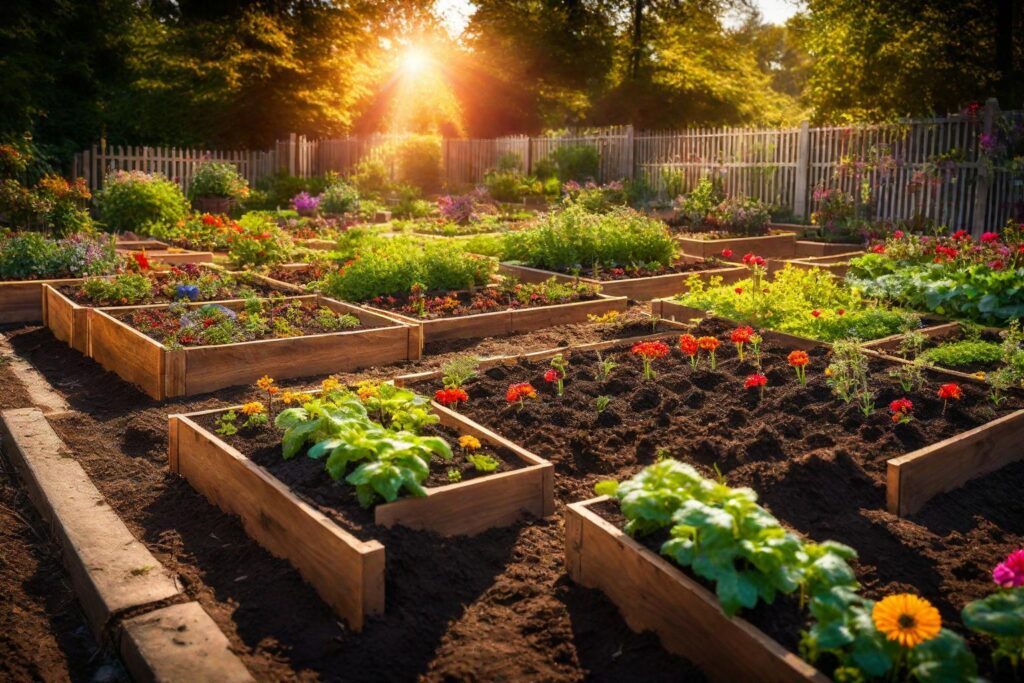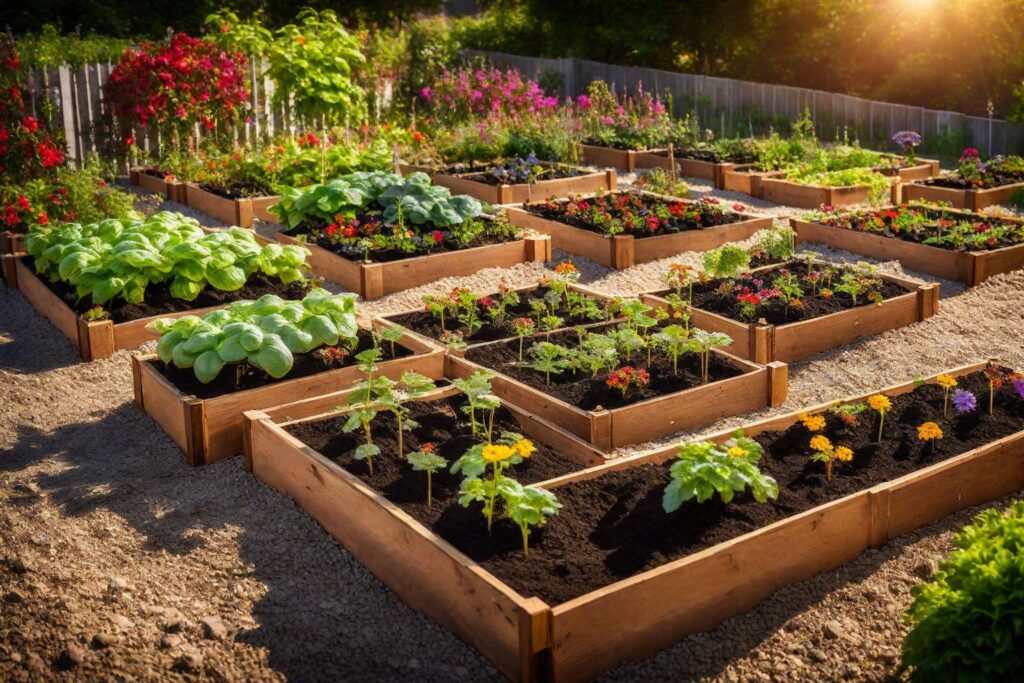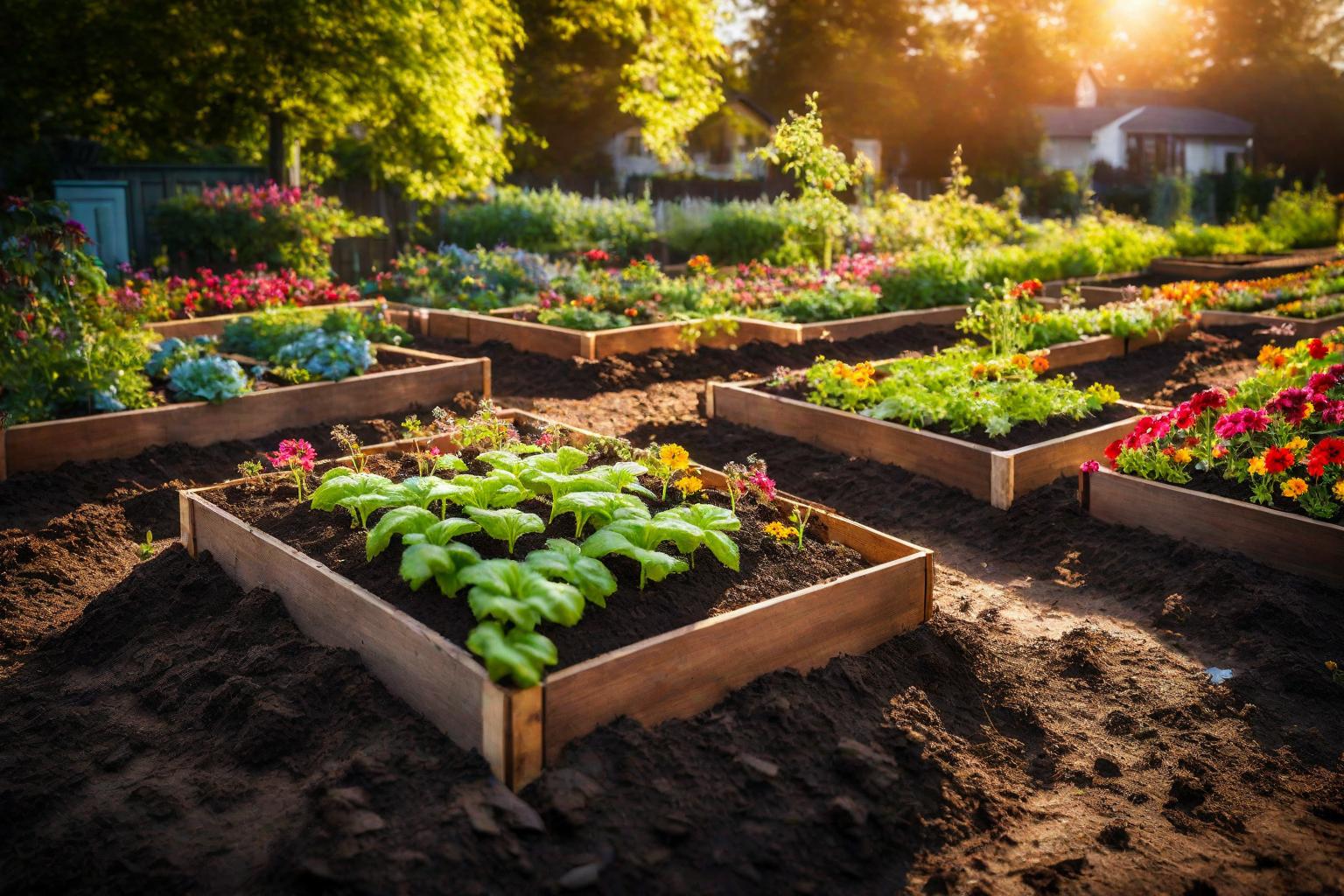Square foot gardening tomatoes in raised bed
“Uncover the secrets of successful square foot gardening tomatoes in raised beds. Learn space-saving methods, soil preparation, and pest management for thriving tomato plants. This comprehensive guide blends efficiency with flavor, offering insights into maximizing yields while minimizing gardening effort. Embark on an informative journey into the world of efficient gardening practices!”
What is Square Foot Gardening?
Square foot gardening is smart gardening method that’s all about using space efficiently. Instead of traditional rows, it divides the garden into small squares. Each square is carefully organized, maximizing the area for different plants.
Benefits of Square Foot Gardening Tomatoes
Space Efficiency: Square foot gardening tomatoes is a smart strategy that optimizes your garden space. By dividing your gardening area into small squares, it ensures that every bit of space is used purposefully. This method allows you to grow more tomatoes in a smaller area, making the most out of limited space.
Reduced Maintenance: With square foot gardening tomatoes, say goodbye to the hassles of excessive maintenance. The well-organized squares help minimize weed growth, making it easier to maintain a tidy garden. Also, the compact arrangement of plants reduces the need for constant watering and pruning. It’s like having a low-maintenance garden that yields abundant tomatoes without demanding endless hours of care.
Enhanced Yield: One of the most appealing aspects of square foot gardening tomatoes is its ability to boost your tomato yield. This method optimizes growing conditions for each plant, leading to healthier and more productive tomato plants.

Choosing the Right Raised Bed for Tomatoes:
Materials for Raised Beds
When selecting materials for your raised bed, durability and sustainability are key factors. Opt for materials that withstand weather elements while being safe for growing edibles like tomatoes. Wood, particularly redwood or cedar, is a popular choice due to its natural resistance to decay and durability. Avoid treated wood, as it may contain chemicals that could seep into the soil. Additionally, consider alternatives like galvanized steel or recycled plastic beds, which offer longevity and are eco-friendly options. Ultimately, the chosen material should align with your preferences, budget, and the aesthetics of your garden.
Optimal Size and Depth
The size and depth of your raised bed play a crucial role in fostering healthy tomato plants. Aim for a width that allows easy access from all sides, typically around 3 to 4 feet wide. This width ensures you can tend to your tomatoes without stepping into the bed, preventing soil compaction. As for depth, a minimum of 6 to 12 inches is advisable, providing ample space for robust root growth. However, deeper beds of around 18 inches can accommodate vigorous root systems, allowing better water retention and overall plant health. Keep in mind that deeper beds may require additional soil and amendments.
Preparing the Raised Bed:
Soil Preparation:
Before planting tomatoes, preparing the soil in your raised bed is vital for their growth. Begin by clearing any debris, rocks, or weeds from the bed. Loosen the soil gently using a garden fork or tiller to ensure proper aeration. This step allows the roots to penetrate easily and access nutrients. Test the soil pH to ensure it’s suitable for tomatoes, aiming for a slightly acidic range between 6.0 to 6.8. Adjust the pH if needed by adding amendments like agricultural lime to raise pH or elemental sulfur to lower it.
Adding Compost and Nutrients
Enhance the soil’s fertility and structure by incorporating organic matter such as compost. Spread a layer of well-aged compost evenly across the bed, about 2 to 3 inches deep. Compost enriches the soil with essential nutrients, improves water retention, and encourages beneficial microbial activity. Consider adding other organic amendments like aged manure, bone meal, or fish emulsion to provide additional nutrients for the tomatoes. Mix these amendments into the top few inches of soil using a garden fork or rake, ensuring they’re thoroughly blended.
This nutrient-rich blend sets the stage for your tomato plants, providing a healthy growing environment that fosters strong root development and vigorous growth. Preparing the soil with compost and essential nutrients ensures your raised bed becomes a thriving haven for tomato plants, offering them a nutrient-packed home for optimal growth and a fruitful harvest.
Planting Tomatoes in Square Foot Gardening:
Spacing Guidelines:
In square foot gardening, precision matters, especially when it comes to spacing tomatoes. The general rule is to allocate one tomato plant per square foot. This optimized spacing allows ample room for growth while maximizing the available space efficiently. Imagine each tomato plant having its designated space to spread its roots and flourish.
Planting Techniques and Depth:
When it’s time to plant, dig a hole in the soil that’s deep enough to accommodate the tomato plant’s roots. Gently remove the plant from its container and place it in the hole, ensuring that the top few sets of leaves are above the soil level. This technique encourages better root establishment and supports the plant’s growth.
Now, here’s a pro tip: consider planting the tomato plant slightly deeper than it was in the container. Burying part of the stem promotes additional root development along the buried portion, leading to a sturdier and more robust plant. Once nestled in its designated square, gently pat the soil around the base of the plant to secure it in place.
Caring for Tomato Plants in Raised Beds:
Watering and Drainage Considerations:
Balanced watering is essential for healthy tomato plants in raised beds. Ensure consistent moisture without overwatering. Raised beds often drain faster, so check the soil moisture regularly and water when the top inch feels dry. Water deeply, allowing the roots to access moisture at a deeper level while promoting healthy growth. Good drainage is equally important. Raised beds aid in proper drainage, but it’s essential to avoid waterlogging. Ensure the bed has adequate drainage holes and avoid excessive watering, as it may lead to root rot. Consider mulching around the plants to retain moisture and regulate soil temperature.
Maintenance Tips for Healthy Plants:
Regular maintenance contributes to robust tomato plants. Pruning is crucial; remove lower leaves to prevent soil-borne diseases and promote airflow. Stake or cage the plants to support their growth and prevent them from sprawling. Feed your tomato plants regularly with a balanced fertilizer or compost tea to provide essential nutrients throughout the growing season. Monitor for pests and diseases, and take proactive measures to address any issues promptly. A vigilant eye helps maintain healthy, thriving tomato plants.
Pest and Disease Management:
Natural remedies for pest control:
For common pests like aphids or caterpillars, natural remedies can be effective. Introduce beneficial insects like ladybugs or lacewings, which prey on aphids, helping control their population. Additionally, neem oil or insecticidal soap, both eco-friendly options, can be used to deter pests without harming beneficial insects or the plants themselves.
Preventive Measures for Diseases:
Disease prevention is key to keeping tomato plants healthy. Implement good square foot gardening tomatoes practices like crop rotation to prevent the buildup of soil-borne diseases. Also, ensure proper spacing between plants for adequate airflow, reducing the risk of fungal infections. Using disease-resistant tomato varieties and planting them in well-draining soil can also mitigate disease risks. Water at the base of the plants to avoid splashing soil onto the leaves, which can spread diseases. Consider mulching to prevent soil-borne diseases from splashing onto the plants during watering. By employing natural remedies for pests and implementing preventive measures for diseases, you’ll create a resilient defense for your tomato plants, ensuring they thrive and produce a successful harvest.

Conclusion:
In the world of gardening, square foot gardening tomatoes in raised beds stands tall, offering a multitude of benefits. From maximizing space efficiency and reducing maintenance to enhancing tomato yields, this innovative approach is a game-changer for garden enthusiasts. The beauty of square foot gardening tomatoes lies in its ability to transform limited spaces into thriving, productive gardens. By optimizing every square foot, you unlock the potential to grow a bounty of tomatoes while minimizing the effort typically associated with traditional gardening methods. With a bit of planning and a touch of creativity, square foot gardening tomatoes can turn your gardening dreams into reality. Start small, experiment, and relish the joy of harvesting your own homegrown tomatoes – it’s an adventure waiting to unfold in your very own garden square!





One Comment